The Intel Broadwell Desktop Review: Core i7-5775C and Core i5-5675C Tested (Part 1)
by Ian Cutress on June 2, 2015 7:45 AM EST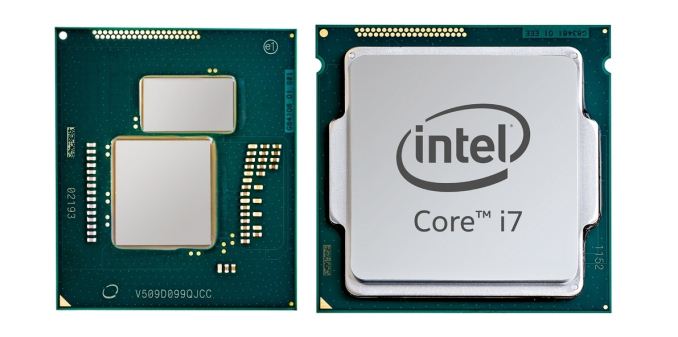
On almost all PC technology forums, it is hard to escape users talking about what Intel’s next processor lineup will be. Due to initial yield issues in Intel’s 14nm node, Broadwell in both mobile and desktop ended up being delayed, somewhat substantially in the case of the desktop. So while motherboard manufacturers released their Z97 platform over 6 months ago, we have been waiting for Broadwell to arrive. That day is today, and we can lay the smackdown with some benchmark numbers too.
The Road to Broadwell
Broadwell, in its top level explanation, is the 14nm die shrink of Haswell which was built on 22nm. Using Intel’s 14nm process this results in a smaller silicon die and lower power consumption. Frequency will depend on the architecture and if the process is suited to frequency or power, but the CPU core underneath is still more-or-less Haswell, with some minor tweaks of course.
As part of Intel’s tick-tock strategy, this would be considered a tick:
| Intel's Tick-Tock Cadence | |||||
| Microarchitecture | Process Node | Tick or Tock | Release Year | ||
| Conroe/Merom | 65nm | Tock | 2006 | ||
| Penryn | 45nm | Tick | 2007 | ||
| Nehalem | 45nm | Tock | 2008 | ||
| Westmere | 32nm | Tick | 2010 | ||
| Sandy Bridge | 32nm | Tock | 2011 | ||
| Ivy Bridge | 22nm | Tick | 2012 | ||
| Haswell | 22nm | Tock | 2013 | ||
| Broadwell | 14nm | Tick | Core-M: 2014 Others: 2015 |
||
If history tells us anything, ticks are usually accompanied by small IPC increases, resulting in 5-10% better performance depending on the benchmark, but ultimately ticks still follow the same capabilities of the processor before them. Intel usually uses its ticks to introduce a new chipset with a large number of capabilities, which we saw with Z97 and its use of M.2/SATA Express on the chipset. If the classical idea of a three year cycle between upgrades is true, then back in the summer of 2012, we were playing around with Ivy Bridge, the tick to Sandy Bridge.
The Broadwell Launch
Back in mid 2014, Intel launched Core M, the first 14nm processor in the mass market and the first Broadwell based product. Core M is the official marketing designation for what was historically the Y series processor (Broadwell-Y), but Core M played a different role to other Y series processors. Core M brought the Core architecture down to a 4.5W thermal design, enabling small and thin fanless 2-in-1 laptop/tablet designs. When the first products started appearing around Christmas and CES, we tested a few and even got down and dirty with the questions that OEMs had to answer with their own chassis designs.
At CES (January 2015), Intel launched Broadwell-U. These devices are aimed more at traditional laptops, mini-PCs and all-in-ones, with the lower-wattage SKUs targeting devices in the 15W range. At the same time higher power 28W SKUs were also announced, with the graphics gamut migrating through the basic Gen 8 package up to Crystal Well based Iris Pro, using onboard EDRAM as an additional cache to improve graphics performance.
After Y and U in Intel’s naming scheme typically comes H, representing higher power (47W-65W) mobile processors or ones suitable for all-in-one type desktop replacement devices which are, for the most part, stationary. H processors are favorites in business due to their high performance, but typically these devices also require large batteries and can come with large (15-17”) screens. They are all soldered down parts as well. Technically some of the H processors are part of the launch today.
After Y, U and H is somewhat of a miasma. The processor lineup, depending on who you speak to, might be DT, S, T, or K. Some of these are also used in the processor names themselves, but we will use Broadwell-DT for consistency. Normally an Intel desktop processor lineup spans a gamut of SKUs, from Celerons, Pentiums, i3, i5 and up to i7. Some ranges consist of 50 or so SKUs, whereby one segment (i5/i7, for example) are launched first and the rest are launched later.
That brings us to today. All-told, Intel is launching ten different SKUs, five 47W laptop and five 65W 'desktop', using a mix of socketed (LGA) and soldered (BGA) parts. All five desktop SKUs are still technically Broadwell-H, and all five are 65W quad-core models featuring Intel's Iris Pro integrated graphics and the product's associated Crystal Well L4 cache. Meanwhile in an interesting turn of events, the two socketed models will be breaking the mold by becoming the first H-family processors to be socketed. These will be the parts we're looking at today.
The Effect of TDP
If we move back to those large processor stacks, Intel tends to produce a range of products from 15W TDP (extreme low power Xeon) through 35W, 55W and up to 84-88W for consumer then 160W for Xeon. Sticking with the consumer line for the moment, the high end overclocking models have recently sat in that 84-88W bracket, donning the i5-K or i7-K moniker and being some of the most talked about processors on forums and for custom builds. Broadwell changes this, and a lot of users might not expect it to.
Because the top Broadwell-DT SKUs are based on Intel's Broadwell-H design, both of the these SKUs ship with a TDP of 65W. As a result, frequencies on the cores are lower, and it means that these processors are best suited for comparison to 65W Haswell processors, such as the i7-4790S or i5-4590S, rather than the i7-4770K or i7-4790K. Thus users looking to upgrade their i5-K or i7-K might be wondering where their 84W processor is.
But both Broadwell-DT processors are overclockable, which adds an element of intrigue. I’ll speak specifically about the Crystal Well implementation in a second, but whether having that extra eDRAM on board effect overclocking is going to be a poignant question moving forward. If a 4.6 GHz Haswell user can also achieve 4.6 GHz on Broadwell, then the benefit of any IPC increase along with the eDRAM might be a driver for purchase. Unfortunately althugh both of the socketed chips are unlocked, due to both time constraints and severe pre-release firmware issues, we're going to have to save overclocking on Broadwell-DT for Part 2 of our coverage.
Integrated Graphics
Intel announced several months ago that Broadwell would be getting the first socketed processor with a Crystal Well implementation that would also be overclockable. For a number of us in the industry, this piqued our interest substantially. Crystal Well, Intel’s name for CPUs that carry extra eDRAM, offers the potential to alleviate DRAM pressure by acting as an L4 cache, but also gives more memory bandwidth for integrated graphics. Given that integrated graphics are typically memory starved to begin with, Crystal Well when announced was an interesting prospect. Unfortunately, for Haswell based models, Intel limited the project to soldered processors only, which meant there was no possible direct desktop comparison. This changes with Broadwell-DT.
Aside from this, in terms of integrated graphics only usage, Broadwell-DT has a full GT3e configuration of execution units that a Broadwell processor has been announced to have. On Core-M we see 24 EUs, Atom x7 with 16, Pentium/Celeron Broadwell-U has 12, while there are various models with 23 or 24 EUs in the Broadwell-U i3/i5 and i7 lines and a few Broadwell-U models with the full 48 EUs with Iris Pro 6100. There will be some Broadwell-H models with 48, which is the number that Broadwell-DT models with the designation ‘C’ or ‘R’ will have.
The current king of the socketed integrated graphics world is AMD’s A10-7870K, which we recently reviewed. Broadwell-DT with Crystal Well is going after that crown.


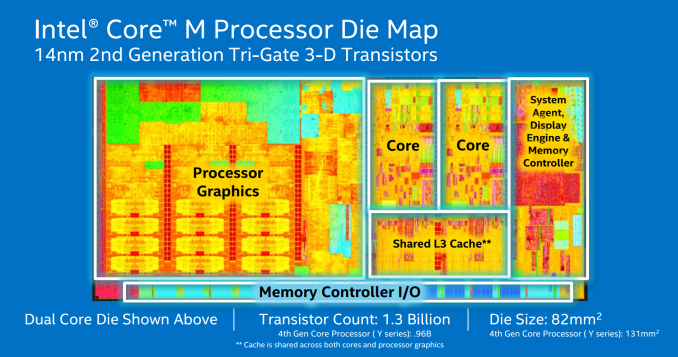
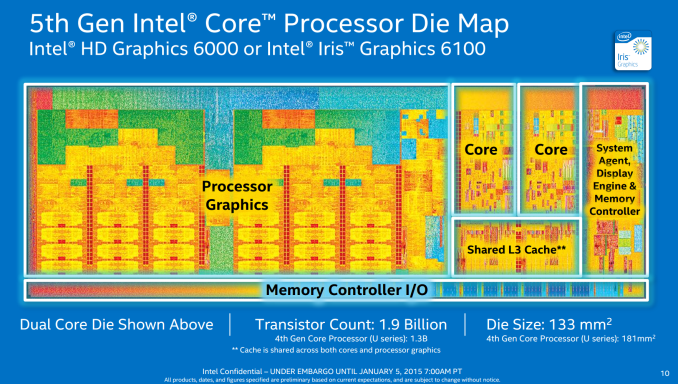
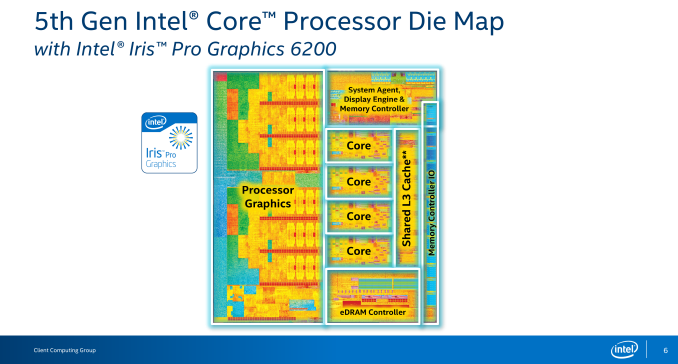
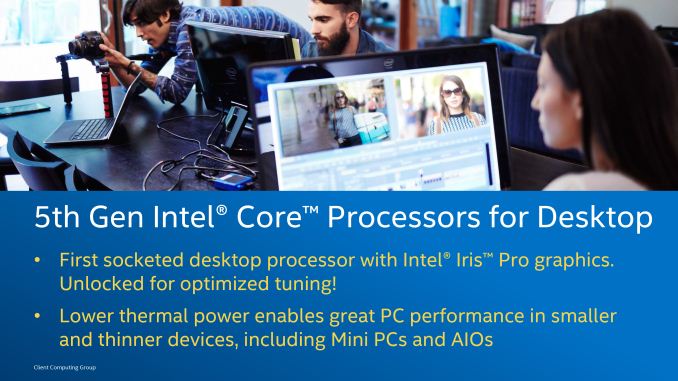
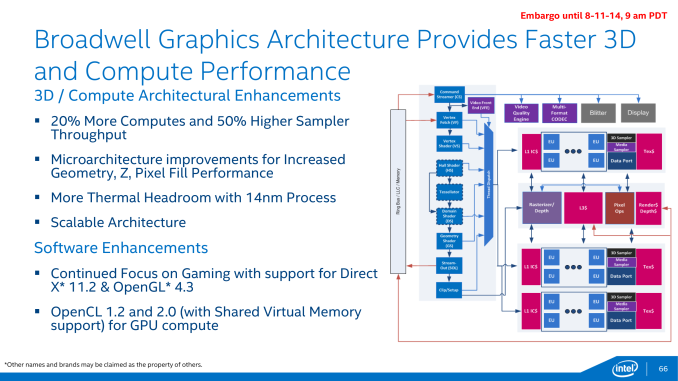








196 Comments
View All Comments
Taneli - Tuesday, June 2, 2015 - link
So how does it compare to 4770R?IUU - Tuesday, June 2, 2015 - link
Good , very good . Now after they have succeeded in this exercise, that is , showing they can build decent igpu, they can finally proceed to the real goal. Make a little bit weaker processors with the same igpu for real laptops, where portability but performance as well are needed at the same time.Then, throw away the burden of the i-gpu part for real desktop parts and complete the desktop series with 80 100 and 130 watts models.
Trying to persuade customers that from now on this is the high end is not going to work. The desktop
or desktop like derivatives should be at the front end of new computer challenges, none of which is
what we describe today as consumer needs(with the exception of gaming of course which admit it or not will always be one of the most demanding software).
Consider that pattern recognition(be it sound video or logic-language) will demand a lot of and parallel processing. Trying to push it as a network based service will not succeed at least as it is
envisioned right now. A significant part of it should be done locally. Now take this advice and conquer or abandon it and fail lol...
bill.rookard - Tuesday, June 2, 2015 - link
I'm not sure that they've proven they can build a decent iGPU. The whole point of integrated graphics is to provide an affordable solution with 'good enough' performance. While they have certainly hit the 'good enough' performance from both a CPU and GPU point of view, they've entirely missed the 'affordable' part of things. For the price of a single Intel CPU, you can almost get an AMD -system- which (while about 10% slower on average) is no small matter.Truth is (as pointed out) you can get an AMD chip with a $100 discrete graphics card which would blow either of the iGPUs away.
mrdude - Tuesday, June 2, 2015 - link
That's the issue both AMD and Intel have had with respect to their iGPUs. Once you've dedicated enough of the die to GPU transistors and skirted around the memory bottleneck (at least for Intel), you end up with a product that, while offering decent GPU performance, is horrendously overpriced for what it offers. Outside of niche scenarios, these things just don't make much sense given just how performance even cheap discrete GPUs can offer.I'd like to see what Intel's margins are on these parts and how much the eDRAM adds to the overall cost of the product. If yields are good and prices aren't much higher, I'd love to see Intel 'bite the bullet' in order to replace the entire product portfolio top-to-bottom. They'd benefit massively from it with respect to market share and being taken seriously with their gaming endeavor.
Unfortunately, I don't think Intel is willing to eat lower margins and a dip in profits for a long term gain, even if it would see a bucking of the current dip in sales with uptick in systems sold.
Refuge - Tuesday, June 2, 2015 - link
They have the best margins in the business.But of course they wont. Why lower prices, make less money now, kill AMD more, and then make more money later possibly if you don't lose out on some BS legal battle over having no compitition. Because it will happen, you know it will.
When instead you can continue to enjoy your large margins with minimal griping because the blame is being split between Intel's greed and AMD's inability to compete. Watch them die slowly, make more money while doing it. They control this playing field, why rock the boat when it is more profitable than it should be already?
Kjella - Tuesday, June 2, 2015 - link
And an Intel chip too, I wonder who are these people who'll pay $276-366 for something that'll get totally trashed by a $64 G3260 + $2-300 discrete graphics card. I guess the target market is AIOs that value style and low power consumption over performance and cost. If you look at their laptop prices, they're the same. So I'm guessing Intel didn't want manufacturers underclocking the 65W chips and using them as cheap 47W laptop chips. And the AIO makers wouldn't like Intel releasing a socketed chip cheaper than the identical BGA chip so the price is set with no grounding to reality in the desktop market.vision33r - Tuesday, June 2, 2015 - link
Majority of people can use G3260 + a decent vid card and have no clue it's a cheap underclass cpu. i5 and i7 are just marketing ploy for clueless people to buy the top level even though they don't know where the performance bottlenecks really are.Notmyusualid - Thursday, June 4, 2015 - link
You know, two of my brothers have i5 CPUs, and my i7 utterly trounces them, in every way. I was expecting the difference to be small, but oh no, for example, one brothers' 3230M does wPrime in < 19s, my i7 < 8s.This speed difference is reflected in the way the PCs 'feels' in every way. I'd say i7's are worth the money, despite seeing some i5s offer up great benchmarks online...
If gaming, then yes, you need an actual decent gpu, but for everything else, CPU counts most...
xulmar - Saturday, June 6, 2015 - link
Are you joking? 3230M? Obviously in laptops the story is different. In desktop the i5 and i7 are comparable, as the i7's main advantage is only the HT, but they still got 4 physical cores all the same. Laptop i5s are crippled processors. If intel would offer an i5 with 4 phsyical cores at a reasonable price - i'd buy it instantly. But 2+2 cores vs 4+4 in laptop i7 is hella difference. Obviously the processor can only be half as fast in multithreaded, if its only HALF of the i7... If you care even a bit about performance in a laptop, i7 is a no brainer, and sadly Intel is pushing the prices up, and replacing the middle class with the U processors which will sadly ruin everyone's dreams about reasonably priced PC performance in the future. This leaves an opportunity for AMD, as soon a quad i7 will be unavailable in any laptop under 1000 dollars...Namisecond - Wednesday, June 3, 2015 - link
"I wonder who are these people who'll pay $276-366 for something that'll get totally trashed by a $64 G3260 + $2-300 discrete graphics card."The same people who don't treat gaming benchmarks as the sole reason for their purchase. Once you get out of gamer culture, you'll find people value (whether mistakenly or not) CPU power over GPU power. In the corporate IT world, installing that $100 discrete GPU card can cost more than the hardware alone.